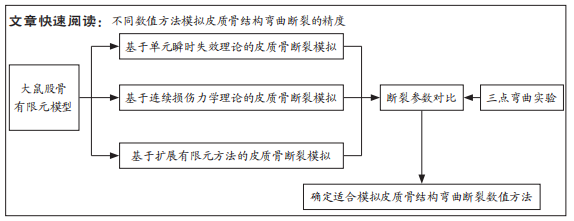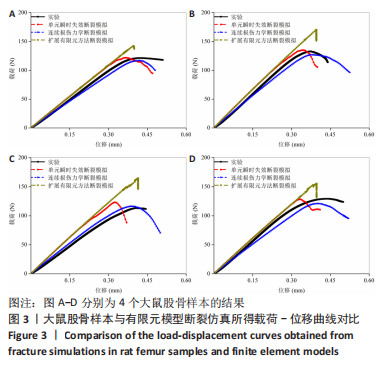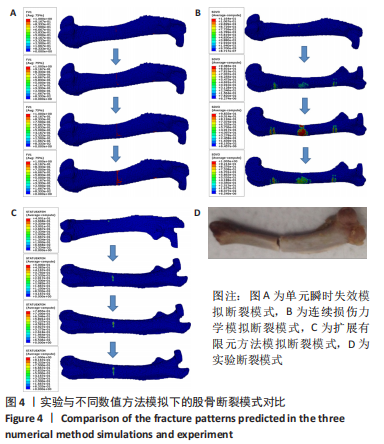[1] 宫赫,张萌,邹珊珊.肌骨系统生物力学建模2021年研究进展[J].医用生物力学,2022,37(1):18-26.
[2] 李木生,林梓凌,郑利钦,等.基于断裂力学的骨质疏松性大鼠股骨颈骨折有限元仿真[J].医学研究生学报,2019,32(9):915-919.
[3] BOWMAN L, LOUCKS AB. In vivo assessment of cortical bone fragility. Curr Osteoporos Rep. 2020;18(1):13-22.
[4] BALA Y, ZEBAZE R, SEEMAN E. Role of cortical bone in bone fragility. Curr Opin Rheumatol. 2016;27(4):406-413.
[5] 安兵兵,李凯,张东升.皮质骨断裂力学行为的实验研究[J].力学学报,2010,42(6):1164-1171.
[6] 王伟军,刘杰,刘军,等.基于不同应变判定准则模拟皮质骨断裂的准确性[J].中国组织工程研究,2022,24(24):3828-3833.
[7] MACNEIL JA, BOYD SK. Bone strength at the distal radius can be estimated from high-resolution peripheral quantitative computed tomography and the finite element method. Bone. 2008;42(6):1203-1213.
[8] KRAIEM T, BARKAOUI A, MERZOUKI T, et al. Computational approach of the cortical bone mechanical behavior based on an elastic viscoplastic damageable constitutive model. Int J Appl Mech. 2020;12(7):2050081.
[9] CRONIN DS, WATSON B, KHOR F, et al. Cortical bone continuum damage mechanics constitutive model with stress triaxiality criterion to predict fracture initiation and pattern. Front Bioeng Biotechnol. 2022;10:1022506.
[10] SALEM M, WESTOVER L, ADEEB S, et al. Prediction of fracture initiation and propagation in pelvic bones. Comput Method Biomec. 2022;25(7):808-820.
[11] YADAV RN, UNIYAL P, SIHOTA P, et al. Effect of aging on microstructure and fracture behavior of cortical bone as determined by experiment and Extended Finite Element Method (XFEM). Med Eng Phys. 2021;93: 100-112.
[12] KUMAR A, GHOSH R. A review on experimental and numerical investigations of cortical bone fracture. Proc Inst Mech Eng H. 2022; 236(3):297-319.
[13] LI JW, GONG H. Fatigue behavior of cortical bone: a review. Acta Mech Sinica. 2020;37(3):516-526.
[14] FANG J, GAO JZ, GONG H, et al. Multiscale experimental study on the effects of different weight-bearing levels during moderate treadmill exercise on bone quality in growing female rats. Biomed Eng Online.2019;18:33.
[15] DAI XF, FAN RX, WU HJ, et al. Investigation on the differences in the failure processes of the cortical bone under different loading conditions. Appl Bionics Biomech. 2022;2022:3406984.
[16] GINER E, BELDA R, ARANGO C, et al. Calculation of the critical energy release rate Gc of the cement line in cortical bone combining experimental tests and finite element models. Eng Fract Mech. 2017; 184:168-182.
[17] 张睿.老龄骨退化及骨质疏松防治的多尺度试验与数值仿真研究[D].长春:吉林大学,2014.
[18] JIA ZB, GONG H, HU SM, et al. Influence of design features of tibial stems in total knee arthroplasty on tibial bone remodeling behaviors. Med Eng Phys. 2017;48:103-113.
[19] FAN RX, LIU J, JIA ZB, et al. Determination of a tissue-level failure evaluation standard for rat femoral cortical bone utilizing a hybrid computational-experimental method. Proc Inst Mech Eng H. 2018; 232(1):80-89.
[20] KUMAR A, SHITOLE P, GHOSH R, et al. Experimental and numerical comparisons between finite element method, element-free Galerkin method, and extended finite element method predicted stress intensity factor and energy release rate of cortical bone considering anisotropic bone modelling. Proc Inst Mech Eng H. 2022;233(8):823-838.
[21] HAMBLI R, ALLAOUI S. A robust 3D finite element simulation of human proximal femur progressive fracture under stance load with experimental validation. Ann Biomed Eng. 2013;41(12):2515-2527.
[22] GAZIANO P, FALCINELLI C, VAIRO G. A computational insight on damage-based constitutive modelling in femur mechanics. Eur J Mech A-Solids. 2022;93:104538.
[23] 李兴国,安兵兵,张东升,等.非自相似分层次结构对骨组织断裂力学性能分析[J].医用生物力学,2021,36(1):30-35.
[24] FAN RX, GONG H, ZHANG XB, et al. Modeling the mechanical consequences of age-related trabecular bone loss by XFEM simulation. Comput Math Method M. 2016;2016:3495152.
[25] GAO X, CHEN MH, YANG XG, et al. Simulating damage onset and evolution in fully bio-resorbable composite under three-point bending. J Mech Behav Biomed Mater. 2018;81:72-82.
[26] CHEN YG, WANG WS, LI X. Fracture analysis of cortical bone under the condition of cement line debonding and osteon pullout. Int J Biomath. 2018;11(2):1850023.
[27] KHOR F, CRONIN DS, WASTON B. Importance of asymmetry and anisotropy in predicting cortical bone response and fracture using human body model femur in three-point bending and axial rotation. J Mech Behav Biomed Mater. 2018;87:213-229.
[28] LAURENTC, BOHME B, MENGONI M, et al. Prediction of the mechanical response of canine humerus to three-point bending using subject-specific finite element modelling. Proc Inst Mech Eng H. 2016;230(7):639-649. |




